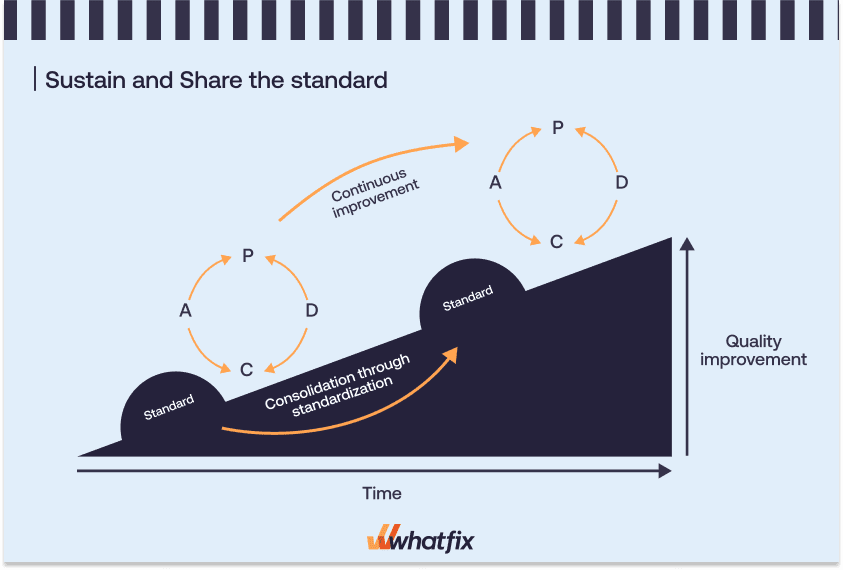What is PDCA? An Effective and Sustainable Continuous Improvement Method
Date: 2025.06.17
PDCA: The Continuous Improvement Method for Sustainable Success
Are you looking for ways to improve work performance or personal life? PDCA is the optimal method used by leading companies to create effective and sustainable change. Whether in business, education, or personal development, PDCA provides a clear roadmap for continuous improvement.
1. What is PDCA?
PDCA stands for four steps: Plan, Do, Check, Act. This is a continuous improvement cycle developed by scientist Walter Shewhart and popularized by W. Edwards Deming – an improvement icon at major corporations like Toyota.
This method helps you solve problems systematically, like a cooking recipe – try, evaluate, and improve to gradually perfect.
2. The 4 Steps of PDCA
🔍 STEP 1: PLAN – Planning
・Clearly identify the problem and objectives
・Answer the questions: What – Why – Who – When – Where – How
・Use tools like: Root Cause Analysis, Fishbone Diagram, Priority Matrix
⚡ STEP 2: DO – Implementation
・Deploy the plan on a small scale
・Collect data, record phenomena
・Don’t arbitrarily adjust the plan
📈 STEP 3: CHECK – Evaluation
・Analyze results, compare with objectives
・Evaluate effectiveness using quantitative and qualitative indicators
・Identify what works and what needs improvement
🚀 STEP 4: ACT – Action
・If successful: Standardize and scale up
・If unsuccessful: Adjust and try again
・If partially successful: Refine and continue new cycle

3. Real-World Applications of PDCA
In Business
Example: A manufacturing company improved eco-friendly packaging by testing cardboard. Result: reduced damage, increased efficiency.
In Learning
Want to learn English better? Apply PDCA to try different learning methods and evaluate progress weekly.
In Other Industries
・Healthcare: Optimize treatment processes
・Education: Improve teaching methods
・Services: Enhance customer care quality
・Marketing: Optimize headlines/ads through A/B testing
4. Benefits of the PDCA Method
| Benefits | Traditional | PDCA |
|---|---|---|
| Systematic improvement | ❌ | ✅ |
| Cost optimization | ❌ | ✅ |
| Organizational capability development | ❌ | ✅ |
| Quick adaptation | ❌ | ✅ |
Risk reduction: Start with small experiments
Increased efficiency: Step-by-step improvement
Building learning culture: All members participate
5. How to Get Started with PDCA
1. Choose a small, controllable problem
2. Create a clear plan
3. Experiment with small scope
4. Check results and learn
5. Act or adjust if needed
🔁 Remember: PDCA is a loop – keep trying, checking, and improving.
6. Six Common Mistakes When Applying PDCA
1. Skipping the check step
2. Implementing large scale from the start
3. Lack of leadership participation
4. No quantitative measurement
5. Stopping after one cycle
6. Not standardizing and communicating results
✅ Tip: Always record data, standardize processes, and continue new cycles.
7. PDCA Support Tools
📋 PDCA Planning Template
・Identify problems and objectives
・Set specific measurement indicators and timelines
・Assign clear responsibilities
・Propose solutions and potential risks
✅ Step-by-step Checklist:
・PLAN: Problem clear? Root cause analyzed?
・DO: Plan executed correctly? Data completed thoroughly?
・CHECK: Results compared with objectives?
・ACT: Solution standardized? New cycle started?
8. Conclusion
PDCA is a simple yet effective method to improve work, learning, and personal life. With a cyclical approach, you’ll gradually progress, reduce risks, and create sustainable change.
👉 Start with a small problem and act today. Improvement isn’t a destination, but a journey you can master with PDCA.






